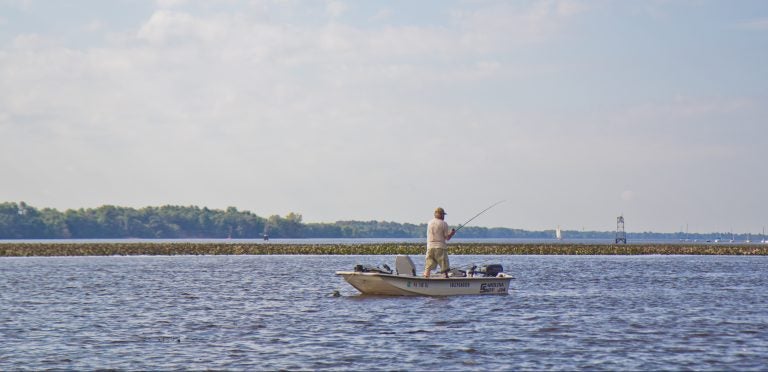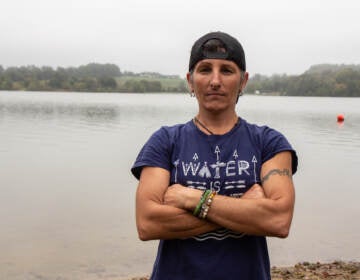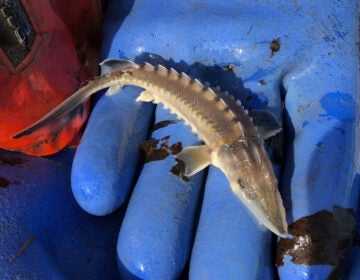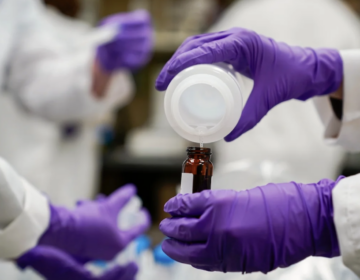A battle brews over use of the Delaware River: Recreational vs. commercial
As more kayakers, paddleboarders, and swimmers take to the Delaware, the commercial shipping industry pushes back, citing safety issues.

File photo: A member of the Delaware River Fishermen's Association fishes for catfish in Bucks County. (Kimberly Paynter/WHYY)
Taking a trip to the banks of the Delaware River on a warm summer day these past couple of years, you may have seen people paddling kayaks, floating on inflatable pink flamingos, racing by on jet skis, and even swimming. It’s a sign that the river, once known as a “stinky ugly mess,” is now much cleaner and more inviting.
It’s also the result of an effort by advocates and environmentalists to encourage more recreational use of the river.
But not everyone is cheering a recreational return to the Delaware. Each year, about 4,000 large cargo ships carry everything from plywood to steel to grapes, delivering material to 30 different marine terminals in the 27-mile stretch between the Tacony-Palmyra Bridge and the Commodore Barry Bridge. Thousands of work boats, including barges and tugs, also travel that stretch each year.
The Maritime Exchange for the Delaware River and Bay, a trade association for the commercial shipping industry that helps manage the traffic, says the increased recreational activities risk fatal collisions with container ships that ply the Delaware. The group is pushing back against efforts to upgrade the river’s regulatory designation under the Clean Water Act.
“Even were the water quality improved, the area would still not be safe for primary contact recreation,” Maritime Exchange president Lisa Himber wrote in a letter to Philadelphia City Council in December.
Though safety and water quality are two distinct issues, they have merged in efforts to upgrade the river’s status under the federal Clean Water Act. A petition filed by environmental groups with the Delaware River Basin Commission in 2020 seeks to improve the 27-mile stretch that runs along Philadelphia and Camden from secondary contact to primary water contact, a designation that aims to make the water “fishable and swimmable.”
That would create more stringent requirements for discharges into the river. Since the primary source of bacteria in the Delaware is the city’s combined sewer overflows, it would have implications for the Philadelphia Water Department.
Himber said that the Maritime Exchange was approached by the Water Department seeking data for a safety study, and that the department showed the trade group social media posts of politicians encouraging recreation.
The commercial shippers aren’t worried about activities along the banks of the river, Himber said.
“If there is an opportunity to provide access to recreational boaters in areas that are not directly near commercial traffic, that’s a completely separate issue from the water quality,” Himber told WHYY News. “We’re just concerned with a blanket ‘Here’s this 27-mile stretch of the waterway and go ahead and recreate all you like.’”
The argument for changing the Delaware’s designation under the Clean Water Act is based on current and growing recreational use of the river and the fact that fish are now breeding in that stretch, said Maya van Rossum, director of the Delaware Riverkeeper Network, which spearheaded the petition.
“The river belongs to the people, not the Maritime Exchange,” said van Rossum. “There’s no evidence that there are collisions or encounters aside from the duck boat. It’s not happening. This is [the Maritime Exchange’s] newest hook to kick people off the river and turn it over to profit-making entities.”
In 2010, a barge hit an amphibious “duck boat” after it stalled on the river. Two Hungarian exchange students died in the accident.
“That’s the sort of thing our members are worried about,” said Himber. Though no fatalities have occurred since, she said anecdotally her members have shared near-miss incidents.
“The primary safety issues are really hurting somebody on the water, hurting the crew, damaging the cargo or the ship itself, and potentially leading to an incident such as a grounding or an oil spill, which is very dangerous,” Himber said.
Both Philadelphia and Camden have centuries-old water systems in which pipes carrying both sewage and stormwater are combined. During heavy rain events, those pipes are overwhelmed, and raw sewage pours into the river. It’s one of the primary sources of river pollution.
PennEnvironment director David Masur said he worries the focus on safety is driven by a reluctance to improve water quality.
“There’s concern that reframing it as a safety issue means [the Water Department] can avoid action on the water-quality issue,” Masur said. “If they can say recreational activity shouldn’t be there, then that means we don’t have to raise the level of water quality.”
He said that the safety issues are overblown, and that commercial traffic can coexist with recreation.
“The reality is during nice weather people are enjoying on-water recreational activities safely all the time. The water quality should meet the uses we see today,” Masur said. “It’s analogous to saying there’s a lot of bad drivers on the road today, so we should have only commercial vehicles and not cyclists or pedestrians.”
The Philadelphia Water Department said that it is working to reduce its sewage discharges into the river, but that an upgrade in regulatory requirements would mean higher costs to ratepayers.
“It’s important for policymakers and PWD customers to understand that a change from secondary to primary contact recreation may require billions of ratepayer dollars in additional investment for infrastructure to further reduce bacteria,” Water Department spokesman Brian Rademaekers said in an email. “We work hard to address the multiple demands of our drinking water, wastewater, and stormwater management systems while balancing the enormous costs of these programs and the financial pressures they put on our customers through rising rates.”
Through its Green City, Clean Waters program, the Water Department says, it has reduced sewage discharges by 2.7 billion gallons each year since 2011, and that it is investing billions of dollars to improve water quality in the Delaware River and its tributaries.
The Delaware Riverkeeper, along with PennEnvironment and dozens of other environmental and educational groups, submitted the 2020 petition to upgrade the river’s designation to the Delaware River Basin Commission. The four-state DRBC regulates water quality in the entire basin and, along with the Environmental Protection Agency, the Pennsylvania Department of Environmental Protection, and the New Jersey Department of Environmental Protection, enforces the Clean Water Act. The riverkeeper’s petition says those now using the river recreationally, and who would come into direct contact with the water, deserve a cleaner river.
Masur said a higher classification of the river as “fishable and swimmable” in the 27-mile stretch between the Tacony-Palmyra and the Commodore Barry bridges is important because it would recognize uses that are already taking place, and would require the DRBC to enact more stringent requirements for industry and wastewater treatment facilities that discharge waste into the river.
“Our biggest challenge is we have a stretch of the Delaware River that is barraged with millions of gallons of untreated sewage and pollution every single year. It’s affecting the water quality, the wildlife, and our ability to enjoy the river,” he said.
The petition to change the designation cites survey data illustrating that the part of the river that runs past Philadelphia and Camden is used for “swimming, snorkeling, tubing, and jet skiing.” It also lists organizations and businesses that provide paddleboard, yoga, and fitness classes, along with youth education programs.
The Clean Water Act, passed in 1972, requires the EPA or its designated state agency — which in the case of the Delaware River is the DRBC as well as the state DEPs — to define appropriate uses for waterways based on water-quality standards. The ultimate goal is to get all rivers and streams to be “fishable and swimmable,” a designation that acknowledges the water quality is safe for primary contact that would include skin contact as well as potential ingestion that comes with swimming, kayaking and paddleboarding, as well as fishing for consumption.
The DRBC’s current designation of that stretch of river as “secondary contact” means the agency says the water quality is unsafe for things such as kayaking and paddleboarding. As a result of that designation, regulatory requirements are less strict. The river between the Tacony-Palmyra and the Commodore Barry bridges has never been clean enough for “water contact sports” as defined by the Pennsylvania water quality standards.
The Clean Water Act requires states to review water quality standards for waterways that don’t meet the primary contact designation every three years. In a rulemaking published by the Pennsylvania DEP in 2020, the agency wrote the designation of the Delaware River between “river mile 108.4 to 81.8” remains secondary contact due to both “significant impacts from combined sewer overflows (CSO), and hazards associated with commercial shipping and navigation.”
Rademaekers said safety is included in the Clean Water Act’s criteria to determine whether a waterway should be designated “fishable and swimmable,” which would change the recommended recreational use of the river.
“PWD’s study is intended to inform Pa. DEP’s next water quality standards review and to ensure that objective, science-based information is at the forefront of any policy decision to potentially change the recreational use in this reach of the Delaware River,” wrote Rademaekers. The Water Department said it will be completed this summer.
The DRBC has yet to make a decision on the petition, but it says it is working through the issues with the agency’s Water Quality Advisory Committee and has conducted enhanced monitoring of bacteria in the Philadelphia/Camden area of the river since 2019, specifically in areas near the banks of the river where the majority of the recreational activity takes place. It has also been collecting samples in the center of the shipping channel to compare the two.
DRBC spokesperson Kate Schmidt said the sources of bacteria include raw sewage from the city’s system of combined sewer overflows and feces from wildlife including geese and dogs, as well as stormwater runoff.
“To date, the data show that concentrations of bacteria are higher near-shore (where people will be/are recreating) than in the center channel,” said Schmidt in an email. “This warrants additional study before any change to the designated use is considered.”
Other concerns regarding fish consumption include chemicals such as polychlorinated biphenyls (PCBs), dioxin, and mercury, toxic remnants from the river’s industrial past. In 1979, the EPA banned the use of PCBs, but they still exist in some products produced before that year. They persist in the environment because they bind to sediments and soils. High exposure to PCBs can cause birth defects, developmental delays, and liver changes.
Gaining a new designation for the Delaware River means regulators will have to update standards for both industry and wastewater treatment facilities, something the petitioners say is crucial.
“Failure to recognize and protect the primary contact recreation uses taking place in the river today puts the health and safety of our river communities and river users at risk,” reads the petition.
The Maritime Exchange said safety and hazards to recreational users by commercial vessels is a factor to be considered, and that if the DRBC decides to change the designation those dangers will increase.
“Mariners aboard commercial vessels cannot necessarily see a swimmer or personal craft operator even at short distances and may not be able to take evasive action if they do,” wrote Himber to Philadelphia City Council.
She added that changing the designation could risk the port of Philadelphia’s economic contribution to the region, which she said is $53 billion, along with “135,000 direct, indirect and induced jobs.”
The DRBC’s Schmidt said safety and hazard mitigation will be considered as part of the decision to change the river’s designation.
On March 7, 11 members of City Council wrote to Himber rejecting her assertions that commercial shipping cannot coexist with recreation. The members pointed out the environmental justice issue of allowing recreation in the upper reaches of the river, where majority white residents enjoy swimming and fishing. All parts of the mainstream Delaware River, aside from where the river passes Philadelphia and Camden, have a primary contact designation.
“Environmental justice demands that cities, like Philadelphia, along the 27-mile urban section of the 330-mile Delaware River have equal access to the same water quality of the rest of the Delaware River,” the council members said.
WHYY is your source for fact-based, in-depth journalism and information. As a nonprofit organization, we rely on financial support from readers like you. Please give today.







